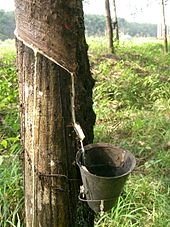**Varieties of Natural Rubber:**
– Amazonian rubber tree (Hevea brasiliensis)
– Congo rubber (Landolphia owariensis and L. spp.)
– Dandelion
– Other plants producing latex rich in isoprene polymers
**Historical and Cultural Aspects:**
– Indigenous Mesoamerican cultures’ first use of rubber
– Evolution of rubber properties understanding
– Rubber trade and cultivation history in South America and Africa
– Introduction of rubber to the Académie Royale des Sciences in France in 1736
**Production and Cultivation:**
– More than 28 million tons of rubber produced in 2017
– Asia accounting for about 90% of natural rubber output in 2021
– Thailand, Indonesia, and Malaysia producing around 72% of natural rubber
– Economic life of rubber trees around 32 years
– Optimum conditions for rubber tree cultivation and high-yielding clones
**Processing and Usage of Natural Rubber:**
– Various steps involved in converting raw rubber into usable forms
– Importance of quality control in processing
– Uses of uncured and vulcanized rubber in various industries
– Transportation methods for shipping natural rubber latex worldwide
– Concerns about rubber shortage, global economics, and market fluctuations
**Chemical Makeup and Properties of Natural Rubber:**
– Polymer structure of cis-1,4-polyisoprene
– Vulcanization process to stabilize rubber
– Elasticity and stress-strain behavior of rubber
– Chemical composition of natural rubber including proteins, fatty acids, and resins
– Vulnerability to vulcanization, ozone cracking, and microbial degradation
Rubber, also called India rubber, latex, Amazonian rubber, caucho, or caoutchouc, as initially produced, consists of polymers of the organic compound isoprene, with minor impurities of other organic compounds. Thailand, Malaysia, Indonesia, and Cambodia are four of the leading rubber producers.



Types of polyisoprene that are used as natural rubbers are classified as elastomers.
Currently, rubber is harvested mainly in the form of the latex from the Pará rubber tree (Hevea brasiliensis) or others. The latex is a sticky, milky and white colloid drawn off by making incisions in the bark and collecting the fluid in vessels in a process called "tapping". The latex then is refined into the rubber that is ready for commercial processing. In major areas, latex is allowed to coagulate in the collection cup. The coagulated lumps are collected and processed into dry forms for sale.
Natural rubber is used extensively in many applications and products, either alone or in combination with other materials. In most of its useful forms, it has a large stretch ratio and high resilience and also is water-proof.[citation needed]
Industrial demand for rubber-like materials began to outstrip natural rubber supplies by the end of the 19th century, leading to the synthesis of synthetic rubber in 1909 by chemical means. [citation needed]
